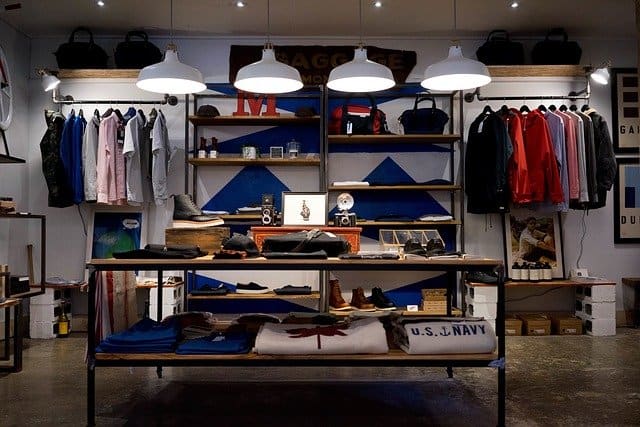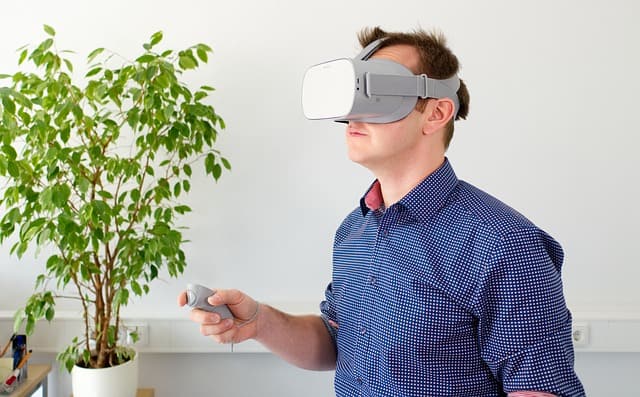VR stands for Virtual Reality that refers to a computer-generated simulation in which one can interact within an artificial 3D environment using special electronic devices (for instance, goggles, gloves, or helmets) and have a realistic experience.
VR in Retail Training Is What Makes the Wheels Spin
When there are new employees in a retail company, it is crucially important to achieve a quick onboarding experience, involve them in the sales process, build cooperative effort, and teach them to work effectively in a team.

The easiest way is to use virtual reality given that this technology creates realistic workplace conditions that help employees train without making adjustments in the workflow.
Indeed, Virtual Reality is a very effective retail simulator as it transports the newbie to the store aisles and gives them an opportunity to interact with customers, handle difficult situations, and develop the necessary skills they may need at work.
Moreover, over the last few years, the cost of VR equipment has decreased; hence, VR technology in retail training is even more popular than ever before.
Benefits of Virtual Reality in Retail Training
As mentioned above, the use of virtual reality as a training tool is becoming more and more common.
There is no need for senior sales managers to leave the floor and spend time on the training of newbies. Instead, one can rely on virtual reality environments.

Apart from that, by using this technology, it is impossible not to notice a wide variety of other great advantages offered by virtual reality:
- safe and controlled training spaces with little or no risk;
- ability to test the simulator remotely thereby saving time and money;
- realistic experiences;
- innovative and enjoyable practices;
- multiple learning styles.
Top 5 Ways To Use VR for Retail Training
The undeniable fact is that virtual reality is drastically changing the way companies approach employee training.
It is one of the areas that benefit the most from this technology revolution and here is why:
1. Building a team and teaching to work effectively
Collaboration between employees is a must in many cases.
For instance, working before during the Great Singapore Sale may be a daunting experience.
This is where VR can be of great help.
By using the technology, the transfer of information is trouble-free, and the staff can act together, help each other, and share experiences to solve the issues.
2. Shortening onboarding
Retail employees can have a high turnover rate, especially when it comes to the holiday season.
Luckily, there is no need to spend much time on training sessions with new hires, be away from the workplace and come up with a specific pattern of learning for a particular individual.
On the contrary, VR technology can teach newbies how to act in different situations by watching the predefined scenarios that really happen or may happen to people in real life.
Moreover, the system tracks employees’ learning and working patterns. Accordingly, customized training seems to be quite a time saver.
3. Quick and easy information sharing
No doubt, leaving the workplace even for a short time to train newbies may harm sales.
This prompted many companies to involve VR technology in certain duties.
Virtual trainers can share information with new hires with little effort – documenting their actions or how they performed a task.
4. Testing changes before involving real-life customers
Nowadays, businesses are changing their operations, and this has become a common practice.
With the help of VR, it is now possible to try out all the updates in a safe environment with no chances to run into real customers before you are ready.
The interactive aspect of VR builds engaging experiences for the newbies and the chance to come up with a strategy on how to work, for instance, with an angry client, or how to train your retail team for a work shift during major sales.
5. Preparing for the worst
Last but not least, it is crucially important to be prepared for such scenarios as robberies, disasters, and any other situations that do not usually happen during ordinary training.
VR is a perfect way to teach newbies how to behave without placing them in dangerous situations.
The knowledge and practice will be useful should any of these incidents occur in the real world.
How Large Retail Companies Use VR to Promote Employees
A major contribution to the promotion of VR training implementation was made by the leading adapter of this technology – Walmart.
At first, the company only used virtual reality in their special academies, but things have changed – now they apply computer-generated simulations to train newbies at their store locations.
The company’s goal is to recreate not only different situations that might happen every day on the floor, but also those that occur from time to time, on specific dates, or even those that may happen out of the blue.
For instance, you cannot be ready for a Black Friday sale unless you know how it feels.
And virtual reality technology can easily demonstrate the situation and teach employees how to deal with the rush, crowd, and chaos.
The great thing about VR is its ability to make learning experiential. When you watch a module through the headset, your brain feels like you actually experienced a situation. We’ve also seen that VR training boosts confidence and retention while improving test scores 10 to 15 percent – even those associates who simply watched others experience the training saw the same retention boosts.
Andy Trainor, Walmart’s senior director of Walmart U.S. Academies
Another good example is IKEA, the world’s largest furniture retailer that holds 445 stores worldwide.
Everybody knows IKEA, and it is partly a virtual reality technology that makes the wheels spin.
The company implemented VR training for their HR team, and the system was delivered in 18 different languages to address cultural differences and diverse learning styles.
During this experience, workers were placed in various situations and even in leadership positions to feel like part of a big global family, practice the company’s key values, help each other, and reach the next professional level.
Today, VR technology is a real breakthrough.
It offers a uniquely personal experience that alters one’s perception of the environment around them. We believe that in the future we will see the real potential of augmented reality.
However, even now we can all admit that virtual reality development has already changed the way people do their businesses.
The coming years will show us other aspects of VR implementation in retail training and other areas.
Time doesn’t stand still, and we must, therefore, keep up minding the importance of adapting to this technology.
This is a guest post by Chiew Ming Hui. He is the Ming Hui is a Project Director at Swag Soft, one of the top rated mobile app development and VR engineering companies in Singapore.





